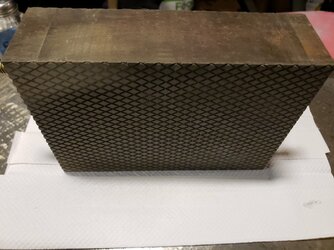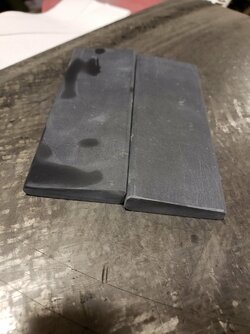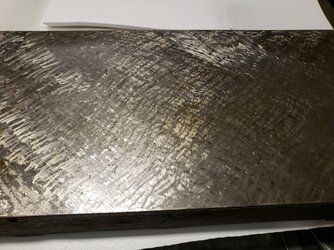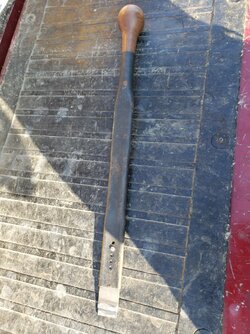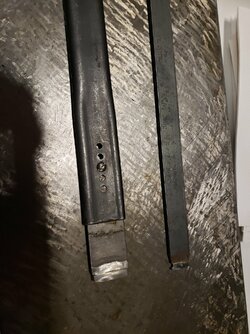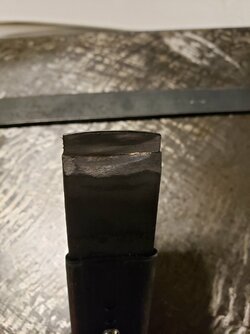You are using an out of date browser. It may not display this or other websites correctly.
You should upgrade or use an alternative browser.
You should upgrade or use an alternative browser.
Getting hones dead flat - a quandry
- Thread starter captaincaed
- Start date
Possible sources of error include
1. Slurry and abrasive buildup on the sandpaper sheet. One disadvantage of this system is that slurry builds up quicky and can affect the results. Try removing it regularly with a rag.
2. Changes in the thickness of the abrasive layer as the SIC breaks down. You are using a course grit. Over time you will dish the surface of the sandpaper as the grit breaks down. The sandpaper should be changed regularly especially at the finish. Finer grits will dish less than course ones.
3. Differential pressure. Try use using two hands with light and even pressure. Rotate the stone regularly to average out differential pressure. Change lapping direction regularly.
4. Curvature of the lapping plate due to differential thermal expansion top and bottom. Try to use water that is as close as probable to the room temperature and the core temperature of the stone. This effect is real. Plates move.
Many experienced honers have proven that perfect results can be achieved from imperfect tools. This is not an excuse to get slack with maintenance. Just understand that nothing on earth is actually ‘dead flat’. Not your surface plate, not your straight edge and certainly not your stones. In this case, close enough really is good enough. That said, you should be able to get very very close with the tools that you have. I don’t use a straight edge to measure flatness of stones. It is too difficult to take accurate reading over a short distance with a straight edge. Testing the gridlines of two stones prepared on the same plate against each other will tell you what’s going on in a couple of strokes. No tools needed. It will also bring the two stones closer to flat as a result of the test.
1. Slurry and abrasive buildup on the sandpaper sheet. One disadvantage of this system is that slurry builds up quicky and can affect the results. Try removing it regularly with a rag.
2. Changes in the thickness of the abrasive layer as the SIC breaks down. You are using a course grit. Over time you will dish the surface of the sandpaper as the grit breaks down. The sandpaper should be changed regularly especially at the finish. Finer grits will dish less than course ones.
3. Differential pressure. Try use using two hands with light and even pressure. Rotate the stone regularly to average out differential pressure. Change lapping direction regularly.
4. Curvature of the lapping plate due to differential thermal expansion top and bottom. Try to use water that is as close as probable to the room temperature and the core temperature of the stone. This effect is real. Plates move.
Many experienced honers have proven that perfect results can be achieved from imperfect tools. This is not an excuse to get slack with maintenance. Just understand that nothing on earth is actually ‘dead flat’. Not your surface plate, not your straight edge and certainly not your stones. In this case, close enough really is good enough. That said, you should be able to get very very close with the tools that you have. I don’t use a straight edge to measure flatness of stones. It is too difficult to take accurate reading over a short distance with a straight edge. Testing the gridlines of two stones prepared on the same plate against each other will tell you what’s going on in a couple of strokes. No tools needed. It will also bring the two stones closer to flat as a result of the test.
Last edited:
Leveling with loose abrasive takes skill. It will inherently build up where it can, and cause what you are describing. This is not a new phenomenon, I believe Iwasaki mentioned it at some point actually. With some stones, you cannot get past it because they are just not perfectly consistent through and through and combined with the tendency of the SIC to 'nest' it causes problems.
One thing that a lot of users get wrong is how much SIC they put on their lapping surface. Just a little is best, the more you use the more you have problems with building up at the edges and crowning.
Unless I am lapping an Ark - or similar - I don't use SIC powder. Mostly because of the build up issues and also that it can embed in a softer stone.
IMO, there really is no point to using SIC for anything other than Arks... Even then, sometimes the stone will just want to crown no matter what you do.
I lap a lot. More than imagined.
For heavy lifting, I use a 140x Atoma. After that a 400x plate.
I have a few of both grits in varying stages of wear.
If I didn't have a diamond plate - I would use SIC w/d paper of good quality.
I lap under running water so the slurry/swarf levels and runs off. You can get build up on a plate also, not quite as easily or as intensely as you can with loose abrasives, but it can/will happen and needs to be flushed.
I will flush when using SIC also, but it's not exactly the same technique, hard to describe, I let water splash up on to the plate, not run directly on it.
One thing that a lot of users get wrong is how much SIC they put on their lapping surface. Just a little is best, the more you use the more you have problems with building up at the edges and crowning.
Unless I am lapping an Ark - or similar - I don't use SIC powder. Mostly because of the build up issues and also that it can embed in a softer stone.
IMO, there really is no point to using SIC for anything other than Arks... Even then, sometimes the stone will just want to crown no matter what you do.
I lap a lot. More than imagined.
For heavy lifting, I use a 140x Atoma. After that a 400x plate.
I have a few of both grits in varying stages of wear.
If I didn't have a diamond plate - I would use SIC w/d paper of good quality.
I lap under running water so the slurry/swarf levels and runs off. You can get build up on a plate also, not quite as easily or as intensely as you can with loose abrasives, but it can/will happen and needs to be flushed.
I will flush when using SIC also, but it's not exactly the same technique, hard to describe, I let water splash up on to the plate, not run directly on it.
"... close enough really is good enough."
In chasing the 'Holy Grail" of flatness, you quickly reach a point of diminishing return. After years of honing hundreds of razors with most every stone I could find. Lapping with granite and steel reference plates, diamond lapping plates, machinist's straight edge tools and many forms of abrasives I'm settled on a few strokes on a DMT lapping plate after every use and all is well. After you hit a couple of decimal places of flatness, your razors just don't care anymore. JMHE
With loose abrasive i use a 1/4 steel plate with groves cut in it. A saw mark roughly every inch across a 12x4 plate. This helps give everything a place to go so the stone stays flat on the plate. I still get a high spot in the stone sometimes either from too much abrasive or too much force. But if i am very careful with my technique, i get a very flat stone off that plate.
“It rubs the lotion on its hair. It rubs the lotion on its hair.”Every now and then, I am reminded that our hobby is a bit strange.
Some excellent points being made, also consider that flat enough is sometimes flat enough. Get yourself a straight edge, remember that slurry can manipulate your pencil grid test and get to flat enough. If your working on 8x3 hones you will be fine.
Greetings mengwong! Welcome to the forum!
Back in the day, 50 or 60 years ago, there were various machine trade jobs, tool and die makers, mold makers, but the most precise and revered of all by the various tradesmen is the gauge maker. Gauge makers usually lapped their work, to precise dimensions, in climate controlled work areas, using cast iron lapping plates, a lot like Pack Lines! Nice score!
Cast iron seems to be quite resistant to grit dishing and if it does it would be a minimal charge to have it ground flat at a machine shop. After literally abusing my cast iron surface plate with nearly a dozen trans/blacks, it had only dished .0015" in the middle. Not what I expected at all...
I did a complete set up on the 3' x 5' (1 x 1.5m) inspection plate at work. I set the 3" x 8"(76 x 203mm)stone on 4 precision blocks on 4 corners and checked the bottom of the stone with a .0001"(.00254mm) dial indicator. I waited until lunch time so there would be no floor vibrations to be picked up. There was absolutely no movement of my indicator dial at all. I had better toolmakers than me check my setup and my reading all agreed it was pretty darn flat. I would call that flat enough....but if you can improve it, why not? Let's see .0001" is about 1/30 of an average head hair. Should work just fine....
I’m working on getting my hones machinist-flat.
Back in the day, 50 or 60 years ago, there were various machine trade jobs, tool and die makers, mold makers, but the most precise and revered of all by the various tradesmen is the gauge maker. Gauge makers usually lapped their work, to precise dimensions, in climate controlled work areas, using cast iron lapping plates, a lot like Pack Lines! Nice score!
Cast iron seems to be quite resistant to grit dishing and if it does it would be a minimal charge to have it ground flat at a machine shop. After literally abusing my cast iron surface plate with nearly a dozen trans/blacks, it had only dished .0015" in the middle. Not what I expected at all...
I did a complete set up on the 3' x 5' (1 x 1.5m) inspection plate at work. I set the 3" x 8"(76 x 203mm)stone on 4 precision blocks on 4 corners and checked the bottom of the stone with a .0001"(.00254mm) dial indicator. I waited until lunch time so there would be no floor vibrations to be picked up. There was absolutely no movement of my indicator dial at all. I had better toolmakers than me check my setup and my reading all agreed it was pretty darn flat. I would call that flat enough....but if you can improve it, why not? Let's see .0001" is about 1/30 of an average head hair. Should work just fine....
Traded a Lincoln for that plate at an auction. It is only 4x6 tho. I have a friend making me a couple more, probably in mild steel. Maybe cast iron if we can source some.Greetings mengwong! Welcome to the forum!
Back in the day, 50 or 60 years ago, there were various machine trade jobs, tool and die makers, mold makers, but the most precise and revered of all by the various tradesmen is the gauge maker. Gauge makers usually lapped their work, to precise dimensions, in climate controlled work areas, using cast iron lapping plates, a lot like Pack Lines! Nice score!
Cast iron seems to be quite resistant to grit dishing and if it does it would be a minimal charge to have it ground flat at a machine shop. After literally abusing my cast iron surface plate with nearly a dozen trans/blacks, it had only dished .0015" in the middle. Not what I expected at all...
I did a complete set up on the 3' x 5' (1 x 1.5m) inspection plate at work. I set the 3" x 8"(76 x 203mm)stone on 4 precision blocks on 4 corners and checked the bottom of the stone with a .0001"(.00254mm) dial indicator. I waited until lunch time so there would be no floor vibrations to be picked up. There was absolutely no movement of my indicator dial at all. I had better toolmakers than me check my setup and my reading all agreed it was pretty darn flat. I would call that flat enough....but if you can improve it, why not? Let's see .0001" is about 1/30 of an average head hair. Should work just fine....
Love my cast iron surface plate. I have 2, one is used for w/d. Already scraped the surface flat once so when it wears a little i will just rescrap it.
WHAT?.. You scraped it? Man, that's a lost art. You just don't hear that mentioned very often. How did you learn? I'd love to know about the tools you use and see a picture or 2.
My employer has had a big surface grinder torn down for 3 years because we can't find someone to scrape the ways in. Everything is disposable now. We can rebuild one of our heavy, 50-60 year old, Grand Rapids grinders and it will outlast a new one by a factor of about 5. No way scrapers to be had. I do think we have the option a shipping the whole mess to a repair shop in Michigan to have it redone. Management has stalled the project.....Geez....
My employer has had a big surface grinder torn down for 3 years because we can't find someone to scrape the ways in. Everything is disposable now. We can rebuild one of our heavy, 50-60 year old, Grand Rapids grinders and it will outlast a new one by a factor of about 5. No way scrapers to be had. I do think we have the option a shipping the whole mess to a repair shop in Michigan to have it redone. Management has stalled the project.....Geez....
Reading, videos, and knowing some old time machinists. Straight edge or a small surface plate is one thing. Not sure if i would try to tackle a machine. Plus doing by hand is very time consuming. Richard King still teaches scraping classes. But it is becoming a lost art. You can see the plate under the stones in the picture.WHAT?.. You scraped it? Man, that's a lost art. You just don't hear that mentioned very often. How did you learn? I'd love to know about the tools you use and see a picture or 2.
My employer has had a big surface grinder torn down for 3 years because we can't find someone to scrape the ways in. Everything is disposable now. We can rebuild one of our heavy, 50-60 year old, Grand Rapids grinders and it will outlast a new one by a factor of about 5. No way scrapers to be had. I do think we have the option a shipping the whole mess to a repair shop in Michigan to have it redone. Management has stalled the project.....Geez....
Attachments
Man I had a 1980 Lincoln town car once. Know why the hood is so big? So you have a place to recline and wait for the tow truck....
A scraped plate with not one but 2 black Ark slips...so sweet. I need to learn this...bad.
A scraped plate with not one but 2 black Ark slips...so sweet. I need to learn this...bad.
They are actually slate slips. Course slate as far as slate goes.Man I had a 1980 Lincoln town car once. Know why the hood is so big? So you have a place to recline and wait for the tow truck....
A scraped plate with not one but 2 black Ark slips...so sweet. I need to learn this...bad.
What does your scraping tool look like? Is it used at high angle or low?
So, when you scrape, you selectively bring down the high areas to meet the low. It makes me wonder if the leveling techniques used in scraping surface plates might have some transferable value to stone lapping. Imagine what the guy that has to dial in big granite surface plates has to go through. He's not going to turn it upside down and lap it, he's going to work down any high spots right there in your shop. Maybe aircraft stuff would require recertification at the factory but most likely the tech is going to do it right there.
It all makes me wonder if certain areas of a stone could be worked on independently to achieve flatness quicker. An example would be lapping a dish out. Each end could be roughed out separately to get the heavy lifting done before going for flat. Less surface area being worked on should go pretty fast rather than fight both end of the stone at he same time. Yeah, I used a sand blaster to erode a seriously, dished soft Ark.
Biggest question of all, would be the Tech dialing in a big granite inspection plate. Could any of his tools or techniques in any way be applied to dialing in an Ark or any stone for that matter.
So, when you scrape, you selectively bring down the high areas to meet the low. It makes me wonder if the leveling techniques used in scraping surface plates might have some transferable value to stone lapping. Imagine what the guy that has to dial in big granite surface plates has to go through. He's not going to turn it upside down and lap it, he's going to work down any high spots right there in your shop. Maybe aircraft stuff would require recertification at the factory but most likely the tech is going to do it right there.
It all makes me wonder if certain areas of a stone could be worked on independently to achieve flatness quicker. An example would be lapping a dish out. Each end could be roughed out separately to get the heavy lifting done before going for flat. Less surface area being worked on should go pretty fast rather than fight both end of the stone at he same time. Yeah, I used a sand blaster to erode a seriously, dished soft Ark.
Biggest question of all, would be the Tech dialing in a big granite inspection plate. Could any of his tools or techniques in any way be applied to dialing in an Ark or any stone for that matter.
Tool looks like a long paint scraper. Blade is about an inch wide. Carbide sharpened at -5° and radiused.
Generally use a similar technique with jnats. I make slurry mainly on the parts if the stone that wear less. So the nagura is effectively wearing the high spots.
On big granite plates they use a cast iron lap and diamond powder. Usually the lap is charged, meaning they put diamond abrasive on the lap and roll it into the lap with a hardened steel roller. Very stable diamond sandpaper. Granite is usually done dry also. I think water can effect the dimensions of granite, not by a lot but when you are dealing in extremely small measurements.
I have not tried charging the lap to do a stone yet. Maybe later this week, i have a hard ark to finish.
Generally use a similar technique with jnats. I make slurry mainly on the parts if the stone that wear less. So the nagura is effectively wearing the high spots.
On big granite plates they use a cast iron lap and diamond powder. Usually the lap is charged, meaning they put diamond abrasive on the lap and roll it into the lap with a hardened steel roller. Very stable diamond sandpaper. Granite is usually done dry also. I think water can effect the dimensions of granite, not by a lot but when you are dealing in extremely small measurements.
I have not tried charging the lap to do a stone yet. Maybe later this week, i have a hard ark to finish.
There is a good video on Ox Tools channel of his surface plates being lapped and calibrated. Large plates are lapped in place, smaller plates are lapped on the lap turned upside down. (Surface Plate Calibration and Conditioning)
Interestingly at about 26:50 the technician says that his cast iron lap is not dead flat but gets flatter each time he uses it. So, you don’t need a dead flat plate to make a flat surface plate.
The same thing goes for stones and razor edges. For lapping, the stone rides on the high spots as does a razor.
Rob Renzetti also has an interesting series of videos where he laps a large 3x4 foot pink granite surface plate that was given to him, it was too worn out to resurface it back to calibration. Not cost effective. (
).
There are also some good videos on both sites on scraping. If you have a hard stone that is dished, use an old file or belt sander to grind it down closer to flat, then lap.
Interestingly at about 26:50 the technician says that his cast iron lap is not dead flat but gets flatter each time he uses it. So, you don’t need a dead flat plate to make a flat surface plate.
The same thing goes for stones and razor edges. For lapping, the stone rides on the high spots as does a razor.
Rob Renzetti also has an interesting series of videos where he laps a large 3x4 foot pink granite surface plate that was given to him, it was too worn out to resurface it back to calibration. Not cost effective. (
There are also some good videos on both sites on scraping. If you have a hard stone that is dished, use an old file or belt sander to grind it down closer to flat, then lap.
It is similar to using a nagura on the high spots to flatten a bench stone. They are always changing to orientation of the lap so any imperfections in the lap do not transfer to the plate. Flat is definitely a relative term. I always aim for between carpenter flat and machinist flat. Good straight edge, not a metal ruler, and light is suitable in my book. Then there is flat in optical terms... that is a whole different rabbit hole.
Similar threads
- Replies
- 5
- Views
- 1K
